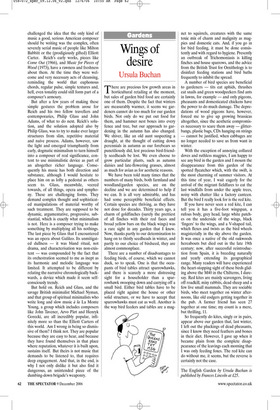Wings of desire
Ursula Buchan
There are precious few growth areas in horticultural retailing at the moment, but sales of garden bird food are certainly one of them. Despite the fact that winters are measurably warmer, it seems we gardeners cannot do too much for our garden birds. Not only do we put out food for them, and hammer nest boxes into every fence and tree, but our approach to gardening in the autumn has also changed. We shiver, like an old aunt suspecting a draught, at the thought of cutting down perennials in autumn as our forebears so punctiliously did, lest precious bird-friendly seedheads be lost. We even choose to grow particular plants, such as autumn daisies and late-flowering grasses, almost as much for avian as for aesthetic reasons.
We have been told many times that the numbers of many birds, both farmland and woodland/garden species, are on the decline and we are determined to help if we can. It is all very admirable, and has had some perceptible beneficial effects. Certain species are thriving, as they have not done for decades. Thirty years ago, a charm of goldfinches (surely the prettiest of all finches with their red faces and broad yellow bars on the black wings) was a rare sight in any garden that I knew. Now, thanks partly to our determination to hang on to thistly seedheads in winter, and partly to our choice of birdseed, they are almost commonplace.
There are a number of disadvantages to feeding birds, of course, which we cannot duck, so to speak. One is that the occupants of bird tables attract sparrowhawks, and there is scarcely a more distressing sight for a householder than a sparrowhawk swooping down and carrying off a small bird. Either bird tables have to be placed right against the house or other solid structure, or we have to accept that sparrowhawks must eat as well. Another is the way bird feeders and tables are a mag net to squirrels, creatures with the same toxic mix of charm and malignity as magpies and domestic cats. And, if you go in for bird feeding, it must be done consistently and with regard to hygiene. Presently an outbreak of Trichomoniasis is killing finches and house sparrows, and the advice from the British Trust for Ornithology is to disinfect feeding stations and bird baths frequently to inhibit the spread.
A number of bird species are beneficial to gardeners — tits eat aphids, thrushes eat snails and green woodpeckers find ants in lawns, for example — and only pigeons, pheasants and domesticated chickens have the power to do much damage. The depredations of wood pigeons have, however, forced me to give up growing brassicas altogether, since the aesthetic compromises necessary to scare them away — glitterbangs, plastic bags, CDs hanging on strings — cannot be justified, when cabbages are no longer needed to save us from want in winter.
With the exception of annoying collared doves and ruthless magpies, I am happy to see any bird in the garden and I mourn the disappearance from this garden of the spotted flycatcher which, with the swift, is the most charming of summer visitors. At this time of year, I wait eagerly for the arrival of the migrant fieldfares to eat the last windfalls from under the apple trees, noisy with chatter like a factory canteen. But the bird I really look for is the red kite.
If you have never seen a red kite, I can tell you it has a five-foot wingspan, a rufous body, grey head, large white patches on the underside of the wings, black ‘fingers’ to the wings, and a V-shaped tail, which flexes and twists as the bird wheels magisterially in the sky above the garden. It was once a native of the old oakwoods hereabouts but died out in the late 19th century; now, after successful reintroduction from Spain, it is breeding naturally and yearly extending its geographical range. Many readers will have experienced the heart-stopping sight of these birds gliding above the M40 in the Chilterns, I daresay. Red kites are mainly scavengers, living off roadkill, mixy rabbits, dead sheep and a few live small mammals. They are sociable birds, who meet together on winter afternoons, like old codgers getting together in the pub. A farmer friend has seen 27 together at one time; my count is a mere, but thrilling, 11.
So frequently do kites, singly or in pairs, appear above our garden that, last winter, I left out the pluckings of dead pheasants, since I know they need feathers and bones in their diet. However, I gave up when it became plain from the complete disappearance of the leavings each morning that I was only feeding foxes. The red kite can do without me, it seems, but the reverse is certainly not the case.
The English Garden by Ursula Buchan is published by Frances Lincoln at £25.


























































































 Previous page
Previous page